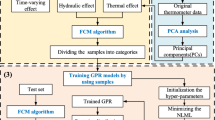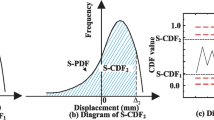Abstract
It is important to determine the warning value of structural behavior for evaluating the service safety, identifying the potential risk and preventing the failure of dam engineering. However, more attention was paid to determining the security warning value of a single observation point on deformation, seepage or stress. And the correlation between the adjacent points or among all points in one dam section is usually lack of consideration. In this paper, the monitoring data of multi-points are taken to determine the spatial warning domain of dam safety. The warning mode of abnormal structural behavior is changed from the single point into the linked multi-points. First, the kernel principal component analysis method is adopted to identify the inherent characteristics among observation points in a dam section. Second, considering the correlation among observation points, the implementation process is proposed to determine the spatial warning domain of dam safety. Finally, an actual concrete gravity dam is taken as an example. The proposed approach is used to determine the spatial warning domains of deformation and seepage. The results, which are obtained by the proposed approach, the traditional method and the qualitative analysis for monitoring data, are compared. It is indicated that the proposed multi-points correlation-based approach is feasible and superior to determine the spatial warning domain of dam safety.






Similar content being viewed by others
References
Chen XD, Gu CS, Chen HN (2013) Early warning of dam seepage with cooperation between principal component analysis and least squares wavelet support vector machine. Fresenius Environ Bull 22(2):500–507
Cheng L, Yang J, Zheng D, Li B, Ren J (2015) The health monitoring method of concrete dams based on ambient vibration testing and kernel principle analysis. Shock Vib. 2015: Article ID 342358
Dambreville S, Rathi Y, Tannenbaum A (2008) A framework for image segmentation using shape models and kernel space shape priors. IEEE Trans Pattern Anal Mach Intell 30(8):1385–1399
Ehiorobo JO, Ehigiator RI (2013) Application of multi-parameter transformation in deformation of dam. Adv Mater Res 824:51–58
Enki DG, Trendafilov NT, Jolliffe IT (2013) A clustering approach to interpretable principal components. J Appl Stat 40(3):583–599
Gu CS, Wu ZR (2006) Safety monitoring of dams and dam foundations—theories & methods and their application. Hohai University Press, Nanjing
Gu CS, Zhao EF, Jin Y, Su HZ (2011) Singular value diagnosis in dam safety monitoring effect values. Sci China Technol Sci 54(5):1169–1176
Jung IS, Berges M, Garrett JH, Poczos B (2015) Exploration and evaluation of AR, MPCA and KL anomaly detection techniques to embankment dam piezometer data. Adv Eng Inform 29(4):902–917
Lei P, Chang XL, Xiao F, Zhang GJ, Su HZ (2011) Study on early warning index of spatial deformation for high concrete dam. Sci China Technol Sci 54(6):1607–1614
Liu HZ, Ding N, Qin D (2014) The determination of deformation monitoring indices using lifting wavelet and multi-component cloud model. Appl Mech Mater 556–562:3001–3005
Martens H, Næs T (1991) Multivariate calibration. Wiley, Chichester
Mercer J (1909) Functions of positive and negative type, and their connection with the theory of integral equations. Philos Trans R Soc A Math Phys Eng Sci 209:415–446
Pearson K (1900) On lines and planes of closest fit to points in space. Philos Mag 2(11):559–572
Price AL, Patterson NJ, Plenge RM, Weinblatt ME, Shadick NA, Reich D (2006) Principal components analysis corrects for stratification in genome-wide association studies. Nat Genet 38(8):904–909
Qin XN, Gu CS, Zhao EF, Chen B, Yu Y, Dai B (2018) Monitoring indexes of concrete dam based on correlation and discreteness of multi-point displacements. PLoS ONE 13(7):e0200679
Ranković V, Grujović N, Divac D, Milivojević N (2014) Development of support vector regression identification model for prediction of dam structural behaviour. Struct Saf 48:33–39
Sortis AD, Paoliani P (2007) Statistical analysis and structural identification in concrete dam monitoring. Eng Struct 29(1):110–120
Su HZ, Hu J, Wu ZR (2012) A study of safety evaluation and early-warning method for dam global behavior. Struct Health Monit 11(3):269–279
Su HZ, Wen ZP, Sun XR, Yang M (2015) Time-varying identification model for dam behavior considering structural reinforcement. Struct Saf 57:1–7
Su HZ, Yan XQ, Liu HP, Wen ZP (2017) Integrated multi-level control value and variation trend early-warning approach for deformation safety of arch dam. Water Resour Manag 31(6):2025–2045
Teixeira AR, Stadlthanner K, Lang EW (2008) KPCA denoising and the pre-image problem revisited. Digit Signal Proc 18(4):568–580
Teizer J (2015) Status quo and open challenges in vision-based sensing and tracking of temporary resources on infrastructure construction sites. Adv Eng Inform 29(2):225–238
Wu ZR, Gu CS, Su HZ, Chen B (2015) Review and prospect of calculation analysis methods in hydro-structure engineering. J Hohai Univ (Nat Sci) 5:395–405
Yu H, Wu ZR, Bao TF, Zhang L (2010) Multivariate analysis in dam monitoring data with PCA. Sci China Technol Sci 53(4):1088–1097
Zhang Y (2009) Enhanced statistical analysis of nonlinear processes using KPCA, KICA and SVM. Chem Eng Sci 64(5):801–811
Acknowledgements
This research has been partially supported by National Natural Science Foundation of China (SN: 51979093, 51739003, 51579083), the National Key Research and Development Program of China (SN: 2018YFC0407101, 2016YFC0401601, 2017YFC0804607), Key R&D Program of Guangxi (SN: AB17195074), Open Foundation of State Key Laboratory of Hydrology-Water Resources and Hydraulic Engineering (SN: 20195025912, 20165042112).
Author information
Authors and Affiliations
Corresponding author
Ethics declarations
Conflict of interest
The authors declare that they have no conflict of interest.
Human and animal rights
Research do not involve human participants and/or animals.
Additional information
Communicated by V. Loia.
Publisher's Note
Springer Nature remains neutral with regard to jurisdictional claims in published maps and institutional affiliations.
Rights and permissions
About this article
Cite this article
Su, H., Wen, Z. & Ren, J. A kernel principal component analysis-based approach for determining the spatial warning domain of dam safety. Soft Comput 24, 14921–14931 (2020). https://doi.org/10.1007/s00500-020-04845-4
Published:
Issue Date:
DOI: https://doi.org/10.1007/s00500-020-04845-4




